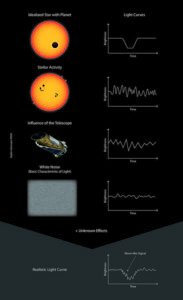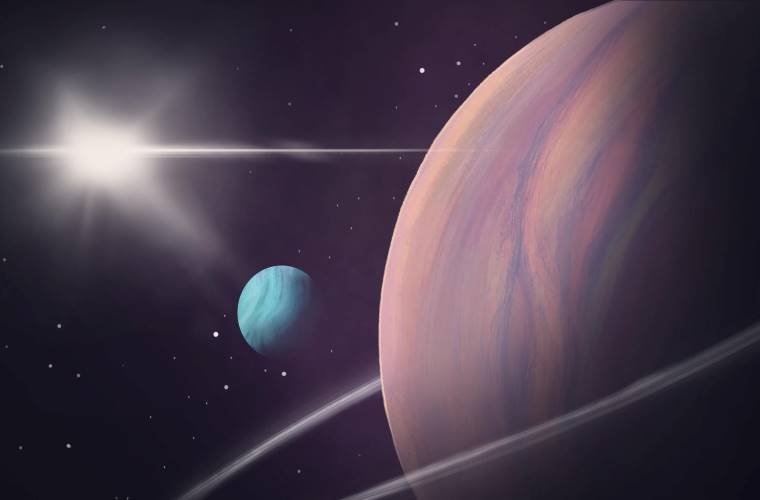Astronomers studying the first and only two exomoons ever discovered outside our solar system say deeper investigations now reveal they don’t exist, and that their detection can be attributed to false signals in the data.
Previous studies using the Hubble and Kepler Space telescopes had reported the discoveries of the two exomoons orbiting the exoplanets Kepler-1625b and Kepler-1708b. This new analysis casts doubt on those findings but also offers astronomers an exciting new tool in the search for exomoons.
Exomoons are Incredibly Difficult to Find, Even With Modern Telescopes
Astronomers first discovered planets outside of our solar system in 1995. Since then, the total of confirmed exoplanets has reached over 5,300, with discoveries of additional candidates still occurring regularly.
Still, astronomers rarely image exoplanets directly due to the incredible interstellar distances involved. Instead, the majority have been spotted due to the dimming they cause when passing in front of their home star, as seen from our point of view. Exomoons, which are moons orbiting those exoplanets, are even harder to spot due to the fact that they are considerably smaller than the planets they orbit.
“Exomoons are so far away that we cannot see them directly, even with the most powerful modern telescopes,” explains Dr. René Heller, the lead author of the newly published study. Instead, the researchers explain, exomoon discoveries also rely on astronomers seeing a tell-tale dimming as the moon and its host planet pass in front of their host star.
As one might expect, this dimming is extremely difficult to detect. Not only are moons expected to be smaller than their host planets, but their orbit around the planet would make their dimming signal appear much more erratic than the one caused by the planet.
To try to solve that problem, Dr. Heller, Dr. Birgit Krummheuer, and the rest of the Max Planck Institute for Solar System Research (MPS) team created a new software algorithm they call Pandora. When they applied their newly developed tool to the only two known exomoons ever discovered, their results were completely unexpected.
Pandora Finds Little Evidence For Kepler-1625b and Kepler-1708b Exomoons
To build their software tool, the MPS team and their collaborators at Sonnenberg Observatory in Germany decided first to simulate all of the various orbits and planet-moon combinations that were possible. This created a database of what the light curve, a.k.a. the dimming caused by the planet and its moon when they transit in front of their host star, of such a pairing would look like.
Next, they used Pandora to corroborate the data from the exomoons found orbiting around Kepler-1625b, which was discovered in 2018, and Kepler-1708b, which was discovered in 2022.


However, instead of confirming those two discoveries, Pandora determined that the light curves that gave previous researchers the indication of exomoons didn’t fit their models. Instead, the light curves observed by Kepler and Hubble fit models of planets without moons at all.
“The probability of a moon orbiting Kepler-1708b is clearly lower than previously reported,” says Michael Hippke from the Sonneberg Observatory and co-author of the new study. “The data do not suggest the existence of an exomoon around Kepler-1708b.”
They made the same observation about the moon orbiting Kepler-1625b, noting that differences in the data between Hubble and Kepler likely provided a false positive. Either way, they ended up determining that both exomoons likely did not exist.
“We would have liked to confirm the discovery of exomoons around Kepler-1625b and Kepler-1708b,” said Heller. “But unfortunately, our analyses show otherwise.”
Study Reveals Which Kinds of Exomoons Current Telescopes Can Realistically Discover
One benefit from the team’s research has been the creation of the likely-positive signal database, which offers future astronomers hunting for exomoons a tool they previously did not have. They also point out that their process has helped determine what type of signals current telescopes like Kepler could spot that would definitively reveal an exomoon.
According to the press release announcing their findings, “only particularly large moons orbiting their planet in a wide orbit are detectable using current technology.” In fact, for our current tools to spot exomoons, the researchers believe it would have to be at a very long orbit and extraordinarily large, even larger than Jupiter’s moon Ganymede, which is the single largest moon in our solar system. Still, they note, if one or more of these massive exomoons were spotted, it would open up any number of exciting possibilities.
“The first exomoons that will be discovered in future observations, such as from the PLATO mission, will certainly be very unusual and therefore exciting to explore,” said Heller.
Christopher Plain is a Science Fiction and Fantasy novelist and Head Science Writer at The Debrief. Follow and connect with him on X, learn about his books at plainfiction.com, or email him directly at christopher@thedebrief.org.

